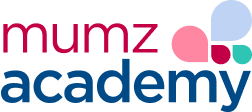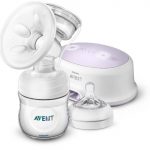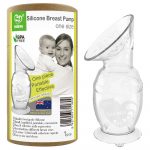The notion that boobs plus baby equal breastfeeding bliss is a nice one. The reality for many mothers, though, is that the whole business takes practice from both of you. If you’re able to breastfeed and choose to do so, you might find you need some guidance, at least initially. Which is where we come in…
View this post on Instagram
According to the NHS, 73% of new mums begin by breastfeeding their babies, and many find it to be a relaxing, bonding experience. That said, it’s not unusual to experience some difficulty getting started or a few hiccups along the way. Whether your baby is struggling to latch on, you’ve bought a breast pump and don’t know how to use it (or are just downright terrified by the noise it makes), or could simply use some friendly advice, you’re in the right place.
The first thing to remember is that while things aren’t always easy, there are a wealth of good reasons to give your baby breastmilk. Here are a few to give you a morale boost in the difficult early weeks:
Benefits of breastfeeding:
- Breastmilk is a complete meal, perfectly designed for your baby
- It can help reduce the risk of infections, diarrhoea and vomiting, and even childhood leukaemia and sudden infant death syndrome
- It helps guard against conditions later in life such as obesity and diabetes
- In mums, it can reduce your risk of osteoporosis, breast and ovarian cancer, heart disease and obesity
- It’s free and available whenever you need it
- It can help develop the bond between mum and baby
Getting started:
Unfortunately, it isn’t usually as simple as offering your baby a breast and telling them to get on with it while you binge on box sets/eat biscuits/drink tea (although those days will come). It can take a bit of time for you and your baby to learn the ropes.
Getting established is like learning any new skill; it can be daunting at first and it’s easy to get dispirited when your baby doesn’t guzzle away on their first attempt, but with a little preparation and perseverance, it usually gets much easier for both you and your baby.
Try to research as much as possible before baby arrives, but if your baby’s already here, don’t panic. A bit of prep always helps but you can’t really get a feel for it all until you can actually get on with it.
Breastfeeding pillows
These can be a real help for many feeding positions and can help you support your baby in the early days, while you develop the knack. The pillows come in all shapes and sizes, from those that you can use as a pregnancy pillow and double up for feeding your baby later, to those that tie neatly around your waist to make picking your baby up for a feed easy. Have a look at a few different models to see what might suit you.
Breastfeeding positions
There are probably more of these than you realise (as a newbie, at least), and it may take a bit of shifting around before you find the one that works best for you. Don’t worry if it feels a bit awkward at first – just get comfortable, make sure your baby’s head and body are supported in a straight line so they can swallow easily, and the rest will come with practice.
- Cradle hold– as the name suggests, cradle your baby across your lap, using the arm on the side that your baby is feeding to support her. Rest the head in the crook of your elbow and let the rest of her lie on your hand. Bring her forward to the breast, rather than leaning forward.
- Rugby hold– place a pillow beside you on the side you intend your baby to feed on and tuck your baby’s body beside you, her hip to yours, under your arm. Support the head with your hand and guide her to the nipple. This a useful position if you have twins.
- Lying down– a good position for night feeds, or if you’re recovering from a birth injury or caesarean. Lie on your side and place your baby’s body parallel with yours and tuck a pillow behind them for extra support.

Is my baby latched properly?
When you start out, it’s hard to know whether your baby is latching on correctly. There are a few things to remember:
- Tummy to tummy: hold her so her tummy is facing into your own, so she doesn’t have to turn her head to feed
- Nose to nipple: bring her nose up to your nipple (not the other way round or you’ll do your back in)
- Wait for the gape: when she opens her mouth wide, bring her onto the breast so she gets a good mouthful
Signs of a good latch include:
- Full cheeks as she is feeding
- You can hear her swallowing but she isn’t making any clicking or smacking noises
- Your baby is gaining weight and you’re seeing lots of wet nappies
If you’ve tried adjusting your feeding position and technique but your baby still is not latching on properly, there could be something else stopping her from feeding correctly. It’s possible she could have thursh, which babies can easily pick up in the birth canal and affects many newborns, or it could be reflux or a medical condition such as tongue tie or a cleft palate (although a cleft palate is usually picked up earlier).
Keep persevering one feed at a time and try to find local clinics.
You know your baby better than anyone else, so if you feel something isn’t right with your latch, speak to your health visitor or GP and they will be able to advise you. Although some pain is to be expected when you start (and don’t worry, nipples do eventually toughen up) pain can also indicate that something is wrong. Listen to your body and trust your instincts.
How many feeds does my baby need each day?
This will change as your baby grows. At first, it will be around 12 feeds in 24 hours and you could be feeding hourly in some parts of the day, but this will gradually reduce to around every three hours and then every four. The best thing is to be guided by your baby.
Signs a baby is hungry
- Sucking her fists
- Making chomping motions with her mouth
- Rooting for the nipple (embarrassingly, she will try this on anyone holding her at the time)
- Wriggling and looking around
- Crying (this is one of the last signs so don’t wait for her to start yelling before you feed her)
Foods to avoid
Eating a varied and nutritious diet is very important for keeping you and your baby healthy. There are few hard-and-fast rules on foods to avoid in general it’s much less prescriptive than the dietary dos and don’ts of pregnancy, you’ll be pleased to hear.
Caffeine and breastfeeding
NHS advice is to limit your caffeine intake to 200mg or less per day, which amounts roughly to two cups of instant coffee. You may be feeling tired as sin, but it’s thought that the caffeine you consume could keep your baby awake – which isn’t what anyone with a newborn is aiming for.
However, a recent review by the University of Warwick has highlighted the need for more extensive research on this subject. The study, by a research team from the university’s medical school, has found no real evidence of positive or negative effects of maternal caffeine consumption on a breastfed baby. But before you stick the kettle on, the team isn’t suggesting that caffeine has no effect at all – it just doesn’t think there are sufficient studies of good quality to inform new mothers about how much caffeine they can actually have.
Lead researcher on the team, Aimee McCreedy said: “It’s understandable that the NHS suggests that breastfeeding mothers restrict their caffeine intake to half of the usual recommended allowance for adults. This cautious approach likely reflects the paucity of good evidence. However, the lack of evidence is surprising given the promotion of exclusive for the first six months from birth and the importance of infant nutrition for health.”
Dr Yen-Fu Chen, the principal research fellow at Warwick Medical School said: “There is ample opportunity for well-designed studies to examine the effects of caffeine intake by mothers on their infants, and such research is overdue given the importance of maternal and child well-being at this crucial stage of life.”
So, the upshot is, there’s no real evidence to suggest 200mg is the correct limit for caffeine intake, but not enough research has been done to provide a more accurate one. Which means it’s probably best to stick to decaf for the most part… Sorry.
Is it safe to drink alcohol while breastfeeding?
It’s best to limit your alcohol intake, though the occasional glass is alright. The NHS recommends you limit your intake to two units once or twice a week. That’s a couple of small glasses of wine, a pint of beer, or two single measures of spirits.
How do I express milk?
Expressing breastmilk can give you flexibility and some respite if you’re finding feeding painful. Whether you express by hand, or with a breast pump allows you to transfer your breast milk into a bottle.
Combining breast and bottle feeding is known as mixed feeding and allows other people, such as your partner, to feed the baby with a bottle yup, this can mean getting your partner to take on a night feed, which means more sleep for you!)
Don’t forget that if you’re using a breast pump and bottles you will need to invest in a steriliser too.
As well as giving you a break from exclusive breastfeeding of your baby, feeding them expressed milk allows you a bit of freedom from avoiding alcohol and certain foods. For example, if you have a night out planned, you can give your baby milk that you’ve expressed beforehand to eliminate any chances of alcohol entering her system through your breast milk.
Expressing can also boost your milk supply, relieve breast engorgement and help a premature baby who is yet to develop their suckling reflux.
Breastfeeding twins
If you’re about to be the mother of twins, you may be wondering how you can feed two babies. Fear not – it is possible when you find a technique, position and routine that works for you including help with tandem feeding and tips for feeding premature twins.
Feeding premature baby or baby in special care
If you had a premature birth or your baby is in a neonatal or special care baby unit for another reason, it might feel like the odds are stacked against you. However, there’s lots you can do to ensure your baby gets the great start that breastmilk offers if you decide you want to give it a go.
If you want to breastfeed your premature baby, or baby in special care make sure you let the unit staff know from the beginning, so you’re all on the same page.
Lots of very premature babies find it difficult to suck, so you may have to express milk and feed your baby using a cup or syringe to begin with. Your baby might also need to be given special newborn formula at first to ‘top her up’ and may need to be tube-fed, too.
How much should my baby weigh?
Your baby will lose some of their birth weight in their first few days but this is nothing to be concerned about. Babies are born with some extra fluid and the loss of this is entirely normal. About 80% of newborns will reach their birth weight again within their first two weeks, although this may take a little longer for some.
Your baby will be measured at certain ages to check that she’s gaining weight at the expected rate. If her weight gain has slowed, it could be for a number of reasons, and your midwives and health visitors will be able to help you get things back on course.
Although your baby’s growth will be continuous throughout their first few years, there will be growth spurts when they grow more rapidly. There are some signs to look out for other than your baby literally growing overnight, such as erratic sleep patterns and clinginess or grumpiness.
How to stop breastfeeding
There is no set time for stopping, really. It’s up to you to decide when to wean your baby off the breast, based on what’s best for both of you.
The consensus among experts, including the NHS and the World Health Organisation (WHO), is that babies should be exclusively breastfed for the first six months of their lives. Breastmilk provides babies with all of the vital nutrients and energy they need to grow and develop. Breastmilk (and formula milk) is also considered better for a young baby’s developing digestive system than solid foods, which is why you’re advised to delay weaning until at least six months.
The WHO recommends you continue, alongside giving your child solid foods, until they are two years old. However, for some mothers, doing so for this long is either impractical or they (understandably) just don’t fancy it. The good news is that everything gets easier the older your baby gets. Not only will you both be old hands at the whole thing but as she drops feeds, it all becomes a bit easier to manage, too. But if you feel you’re ready to start weaning off the breast you can pat yourself on the back no matter how far you got. Every little helps, as they say.
Other articles you might be interested in:
How to Transition from Breastfeeding to Solids?
Can I Return to Work and Continue Breastfeeding? The Answer is Yes!












